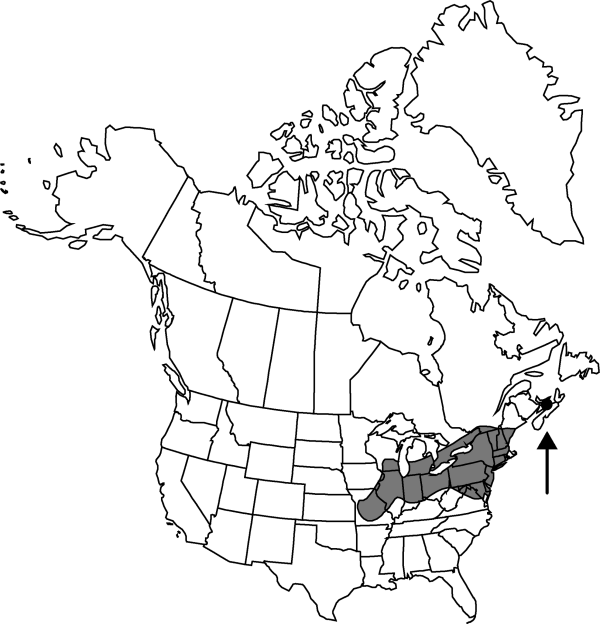Difference between revisions of "Chenopodium urbicum"
Sp. Pl. 1: 218. 1753.
FNA>Volume Importer |
FNA>Volume Importer |
||
| Line 24: | Line 24: | ||
|elevation=0-600 m | |elevation=0-600 m | ||
|distribution=N.S.;Ont.;Que.;Conn.;Del.;Ill.;Ind.;Iowa;Maine;Md.;Mass.;Mich.;Mo.;N.H.;N.J.;N.Y.;Ohio;Pa.;R.I.;Vt.;W.Va.;Wis.;native to Europe;Asia;occasionally introduced in other parts of the world. | |distribution=N.S.;Ont.;Que.;Conn.;Del.;Ill.;Ind.;Iowa;Maine;Md.;Mass.;Mich.;Mo.;N.H.;N.J.;N.Y.;Ohio;Pa.;R.I.;Vt.;W.Va.;Wis.;native to Europe;Asia;occasionally introduced in other parts of the world. | ||
| − | |discussion=<p>Judging from its leaf morphology and anatomy, inflorescence structure, and floral characteristics, <i>Chenopodium urbicum</i> probably should be transferred to subg. Blitum, where it would occupy a position transitional toward subg. <i>Chenopodium</i>. Two rather distinct varieties are usually recognized: var. urbicum (= C. deltoideum Lamarck) with triangular leaf blades truncate at base, and < | + | |discussion=<p>Judging from its leaf morphology and anatomy, inflorescence structure, and floral characteristics, <i>Chenopodium urbicum</i> probably should be transferred to subg. Blitum, where it would occupy a position transitional toward subg. <i>Chenopodium</i>. Two rather distinct varieties are usually recognized: var. urbicum (= C. deltoideum Lamarck) with triangular leaf blades truncate at base, and <i></i>var.<i> intermedium</i> (Mertens & Koch) Koch [= var. rhombifolium (Muhlenberg ex Willdenow) Moquin-Tandon] with rhombic leaf blades cuneate at base. Both entities occur in North America.</p><!-- |
--><p><i>Chenopodium urbicum</i> has been reported from several other provinces and states including British Columbia, New Brunswick, Louisiana, Oregon, and Washington. We have not been able to verify these locations.</p> | --><p><i>Chenopodium urbicum</i> has been reported from several other provinces and states including British Columbia, New Brunswick, Louisiana, Oregon, and Washington. We have not been able to verify these locations.</p> | ||
|tables= | |tables= | ||
| Line 34: | Line 34: | ||
-->{{#Taxon: | -->{{#Taxon: | ||
name=Chenopodium urbicum | name=Chenopodium urbicum | ||
| − | |||
|authority=Linnaeus | |authority=Linnaeus | ||
|rank=species | |rank=species | ||
| Line 50: | Line 49: | ||
|publication year=1753 | |publication year=1753 | ||
|special status= | |special status= | ||
| − | |source xml=https://jpend@bitbucket.org/aafc-mbb/fna-data-curation.git/src/ | + | |source xml=https://jpend@bitbucket.org/aafc-mbb/fna-data-curation.git/src/f50eec43f223ca0e34566be0b046453a0960e173/coarse_grained_fna_xml/V4/V4_535.xml |
|genus=Chenopodium | |genus=Chenopodium | ||
|subgenus=Chenopodium subg. Chenopodium | |subgenus=Chenopodium subg. Chenopodium | ||
Revision as of 22:40, 16 December 2019
Stems erect, simple or rarely branched, 3–10 dm, glabrous. Leaves nonaromatic; petiole 1.5–3.5 cm; blade mostly triangular or rhombic in proximal leaves, triangular, rhombic, or lanceolate in distal leaves, 3–11 × 3–10 cm, base truncate to broadly cuneate, margins sinuate to dentate (occasionally ± entire), often with obtuse to acute outward-pointing lobes at base, apex obtuse to acute, glabrous. Inflorescences glomerules in terminal panicles and lateral spikes or compound spikes, 3–4.5(–8) cm; glomerules subglobose, 2–3.5 mm diam.; bracts absent. Flowers: perianth segments 5, distinct nearly to base; lobes broadly ovate to elliptic, 0.6–0.8 × 0.4–0.8 mm, apex obtuse or retuse, rounded or with slight broad keel abaxially, glabrous, only slightly covering fruit at maturity; stamens 5; stigmas 2, 0.1 mm. Utricles depressed-ovoid; pericarp nonadherent, papillose to smooth. Seeds rarely few vertical, lenticular, round, 0.8–1.2 mm diam.; seed coat black (reddish brown), shiny.
Phenology: Fruiting late summer–fall.
Habitat: Waste places, especially about cities and towns, along railroad tracks
Elevation: 0-600 m
Distribution

N.S., Ont., Que., Conn., Del., Ill., Ind., Iowa, Maine, Md., Mass., Mich., Mo., N.H., N.J., N.Y., Ohio, Pa., R.I., Vt., W.Va., Wis., native to Europe, Asia, occasionally introduced in other parts of the world.
Discussion
Judging from its leaf morphology and anatomy, inflorescence structure, and floral characteristics, Chenopodium urbicum probably should be transferred to subg. Blitum, where it would occupy a position transitional toward subg. Chenopodium. Two rather distinct varieties are usually recognized: var. urbicum (= C. deltoideum Lamarck) with triangular leaf blades truncate at base, and var. intermedium (Mertens & Koch) Koch [= var. rhombifolium (Muhlenberg ex Willdenow) Moquin-Tandon] with rhombic leaf blades cuneate at base. Both entities occur in North America.
Chenopodium urbicum has been reported from several other provinces and states including British Columbia, New Brunswick, Louisiana, Oregon, and Washington. We have not been able to verify these locations.
Selected References
None.